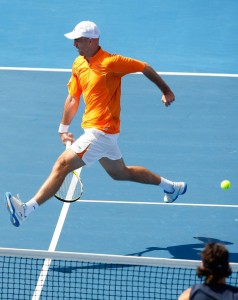By and large, I have little time for statistics in sport, suspecting they were invented by Americans intent on ensuring the viewing public enjoys itself less. While stats at their best can prove illuminating when judiciously applied, at their worst they are worse than useless, crude or subtle distortions, yoked to dull agendas.
There is also the uneasy sense that for any sport to require so much explicative number-crunching, it must surely have something wrong with it. What is lacking, we might reasonably ask, that so many statistics are required to compensate? To foreign eyes, this seems especially so in American sports, which often seem little more than a framework over which endlessly permutating numbers may be draped to greatest advantage.  Sadly, Australian sports are headed that way. Australian readers may know of Championship Data, who provide the thoroughgoing statistical analysis for the AFL and its various clubs. Champion’s breakdowns of each game are so detailed that they provide a level of understanding surpassed only by actually watching the game, and for only ten times the effort. Larger, global markets surely have their conglomerated equivalents, perpetually threatening to overwhelm the viewer, and to divest the activity of any whimsy it may lay claim to. Ultimately, the best sports say most things on their own, if permitted to, and if played or watched.
Sadly, Australian sports are headed that way. Australian readers may know of Championship Data, who provide the thoroughgoing statistical analysis for the AFL and its various clubs. Champion’s breakdowns of each game are so detailed that they provide a level of understanding surpassed only by actually watching the game, and for only ten times the effort. Larger, global markets surely have their conglomerated equivalents, perpetually threatening to overwhelm the viewer, and to divest the activity of any whimsy it may lay claim to. Ultimately, the best sports say most things on their own, if permitted to, and if played or watched.
Still, with all of that said, tennis is among the few mainstream sports that is under-served by statistics. There are several reasons for this. Firstly, a great deal of tennis statistics are either inherently useless, or so thoroughly deprived of context that they grow senseless. Think, for example, of the casual equivalence that has been established between winners and unforced errors, with the implication being that the two are somehow aspects of the same thing. Forced errors, which we never hear about, and for which I’m no longer certain stats are even recorded, are generally far more revealing. The same goes for aces and double faults, which aren’t equivalent, and mean very different things when down match point than they do at 15-15 in the middle of a set. Or about break points converted or saved, which may be revealing when viewed across very large data sets, but within the context of a single match tell you hardly anything, and certainly nothing that isn’t more apparent from just watching the encounter unfold.
Secondly, statistics actually do serve a useful purpose quite apart from boring viewers to death, which is in measuring performance. In tennis – especially in singles – we have something called ‘the score’ to tell us that, and it generally lets you know who the superior player was on the day.  However, in team sports performance measurement becomes far more complex, an inevitable result for any system involving a lot of moving parts. The performance of any single part is not necessarily reflected in the outcome of any given game. The score can only tell you so much, especially as results may take a while to reveal under-performance in a given player. With tennis, though, there’s just a person with a racquet. To the even moderately practised eye, on court performance on any given day will pretty much speak for itself. The numbers are just padding.
However, in team sports performance measurement becomes far more complex, an inevitable result for any system involving a lot of moving parts. The performance of any single part is not necessarily reflected in the outcome of any given game. The score can only tell you so much, especially as results may take a while to reveal under-performance in a given player. With tennis, though, there’s just a person with a racquet. To the even moderately practised eye, on court performance on any given day will pretty much speak for itself. The numbers are just padding.
Of course, it is in comparing that match to other matches that the real statistical interest lies, and where useful information resides. This is the area in which tennis has lagged behind, and is only gradually catching up. Perhaps surprisingly, it is the efforts of hobbyists and bloggers that are yielding some of the finest results – amateurs maintaining their own databases, sifting through mountains of results, and sometimes throwing up some really fascinating results (and, inevitably, a great deal of pretty boring shit, as well).
Here are some useful sites devoted to statistical analysis of tennis, maintained tirelessly and often thanklessly, and with a devoted patience that I can barely fathom:
- Core Tennis
- Heavy Topsin
- Voo de Mar
- Stat Racket
- Ricoh Matchfacts (ATP website)
- Shark Bites (ATP website)
